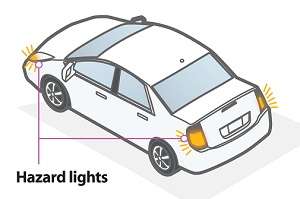VEHICLE LIGHTING LAWS: All motor vehicles MUSTuse their headlights during the enforced lighting-up time on unlit public roads.
Note: UK parking laws provide exceptions to vehicle lighting requirements in some circumstances.
Enforced Lighting Up Time UK
The Highway Code rules give a clear definition of nighttime or lighting-up time. As a rule, it defines the hours of darkness as the time between half an hour after sunset and half an hour before sunrise.
Note: Drivers should also use headlights when the road visibility is seriously reduced (less than 100 meters). Examples would include driving in adverse conditions such as fog or heavy rain.
Highway Code Headlights and Vehicle Sidelights
Rule 113: Car drivers MUST ensure that all vehicle sidelights are lit between sunset and sunrise while driving.
The same vehicle lighting laws also apply to rear registration plate lights. You must also use the headlights at night time unless the road has lit street lighting.
As a rule, the roads with supplemental street lighting restrict speed limits to 30 mph (48 km/h) unless specified otherwise.
Note: You can report a problem with a street light to the local council. They have the responsibility of installing and maintaining street lights.
Rule 114: Motorists MUST NOT use any vehicle lights in a way which would dazzle or cause discomfort to other road users. These lighting requirements also relate to dazzling pedestrians, horse riders, or cyclists.
Drivers MUST NOT use front or rear fog lights under normal driving conditions. The exception would be if visibility is seriously reduced. Fog lights must then get switched off when the visibility improves.
Note: The Road Vehicle Lighting Regulations Act 1989 got amended in the United Kingdom. It now covers the legal requirements for the use of headlamps and front fog lamps.
Car Lights Rules in Stationary Traffic
Drivers should apply the parking brake in situations where the vehicle queues in stationary traffic.
You should then remove your foot off the foot brake when traffic behind you has stopped. Deactivating vehicle brake lights helps to reduce glare to road users behind you.
Rule 115: Vehicle lighting laws and requirements also state you should:
- Use dipped headlights (or dim-dip) at night time in built-up areas and in dull daytime weather.
- Keep your headlights dipped when overtaking until you are level with the other vehicle.
- Slow down, or stop if necessary, any time you get dazzled by oncoming headlights.
 Highway Code Hazard Warning Lights
Highway Code Hazard Warning Lights
Rule 116: Drivers can use hazard warning lights when the vehicle is stationary.
Use car hazard lights to warn others that your car is, or may be, temporarily obstructing traffic flow.
Highway Code Hazard Lights on a Motorway
Motorists MUST NOT use hazard warning lights while driving or getting towed. Some exceptions apply such as on motorways or unrestricted dual carriageway.
The orange flashers will warn drivers behind you that there is a hazard or obstruction ahead. But, only activate hazard lights long enough to ensure that your visible warning got observed by other road users.
Note: When may you use hazard warning lights when driving? Never use hazard warning lights as an excuse for illegal parking or dangerous driving.

